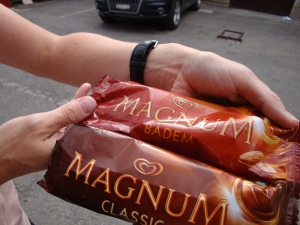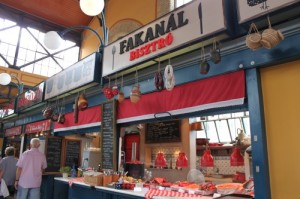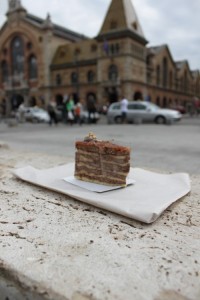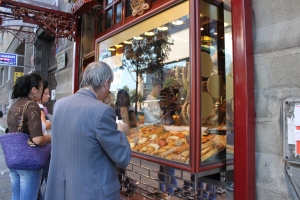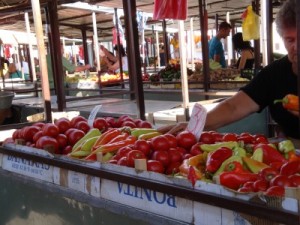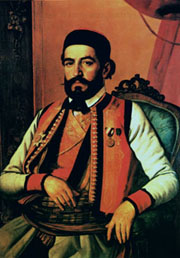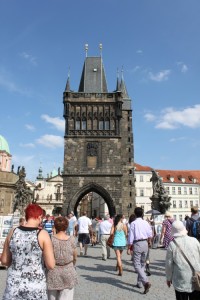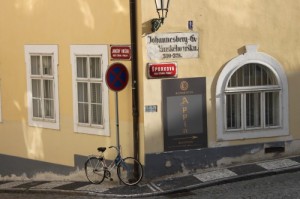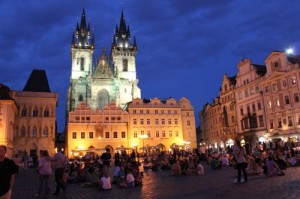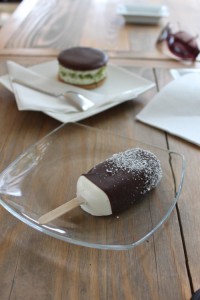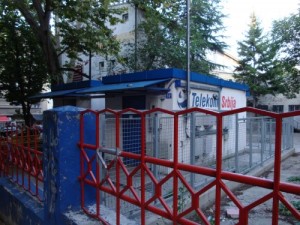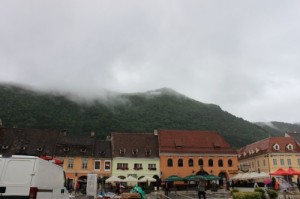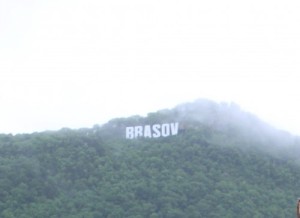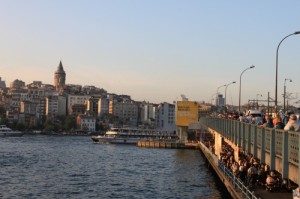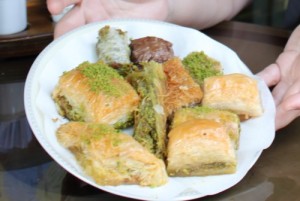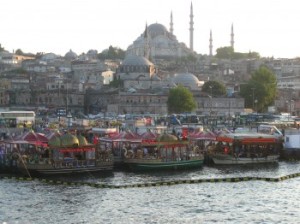Djokovic pays top dollar for his slice…of cheese

Who has two thumbs and likes expensive cheese?
According to The Sun, Serbian tennis star Novak Djokovic has bought the entire 2013 supply of the world’s most expensive cheese, costing £800 a kilo, or almost $650 a pound. (Meanwhile, I’m too cheap to buy the good brie…)
The cheese is called pule, named after a young donkey. I think. (I don’t even know what a young donkey is called in American english. Cub? Foal?) Anyway, as the name implies, the cheese is made from donkey milk. The donkeys are from Zasavica, Serbia, northwest of Belgrade. According to my bad translation of this article, it takes 50 liters of donkey milk, taken by hand, to make one kilogram/2.2 pounds of cheese. The milk is prized as anti-allergenic, particularly when raw, as donkey milk has 60 times more vitamin C than cow milk.
I’m sad to say I’ve never heard of this cheese before. Who knew I had been living so close to the world’s most expensive cheese? Who knew the world’s most expensive cheese is from Serbia?
Anyway, Djokovic is going using his year’s supply of cheese for a his chain of restaurants in Serbia, called Novak. The Belgrade Novak restaurant is conveniently located by the Djokovic tennis courts. I’m not sure how many people can afford $650/lb cheese in Serbia, but I’ll make him a deal: if there’s a ton left over, I’ll come by next summer and challenge him to a tennis match. Whoever loses gets a pound of pule sir. Do I drive a hard bargain or what?
Pet Peeve Petak: the Belgrade ban on…Magnum Ice Cream
 Ok, I admit it: I’ve got a soft spot for Belgrade. I’ve always focused on the things I loved about the city, because there were more than enough negative misconceptions about it. And yet, after two years of managing this blog, I think I’m ready to log a serious complaint about the white city.
Ok, I admit it: I’ve got a soft spot for Belgrade. I’ve always focused on the things I loved about the city, because there were more than enough negative misconceptions about it. And yet, after two years of managing this blog, I think I’m ready to log a serious complaint about the white city.
There is, as of this September, NO MAGNUM ICE CREAM in Belgrade.
I was first alerted to Magnum Ice Cream in August 2011. My friend Majmun came to visit Belgrade, and after a long walk we decided to buy the sweet stuff. She looked at various ice cream carts before asking me, “Do you have Magnum ice cream here?” I shrugged, and she extolled the virtues of the Magnum. Thick chocolate! Vanilla bean-flecked ice cream! Every flavor delicious!
I thought she was overselling it, until we encountered it while walking in Sarajevo a few days later.
It. Was. Amazing.
After discovering the magic of magnum, I redoubled my efforts to find it in Belgrade, only to come up empty-handed. So Muz and I decided to try to find it in other countries. We ate raspberry Magnum in Vienna, Classic Magnum in Macedonia, Almond Magnum in Budapest, Caramel Magnum in Croatia, and even had a Magnum McFlurry at a McDonald’s in Prague. (Don’t judge–they had great wireless!)
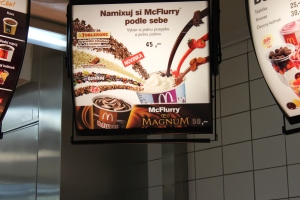
We traveled quite a bit, but it never took the sting out of missing Magnum in Serbia. It was available over almost every border: in Croatia, Hungary, Bosnia, and (I think) Slovenia. It felt a bit cruel. What’s preventing Serbia from importing Magnum?
In retrospect, maybe it was a good thing we didn’t have Magnum in Belgrade. It would have become less special, or we would’ve become a lot bigger. And there are plenty of other outlets for the ice cream itch in town. Now that we’re back, we still keep it as a special treat. But that doesn’t mean it’s not a serious pet peeve. 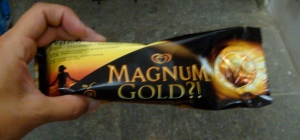
Thanksgiving: American Slava
 After my grumpy post yesterday, and my three hours of pre-Thanksgiving cooking today, I realized: Thanksgiving is basically American slava.
After my grumpy post yesterday, and my three hours of pre-Thanksgiving cooking today, I realized: Thanksgiving is basically American slava.
A slava is the celebration of a Serbian family’s patron saint. I’ve been told that the family saint is selected according to the proximity of a Saint’s celebration to the date that the Serbian family accepted the Orthodox religion. That’s the (sort of) official version.
Unofficially, a slava is a crazy day–or two–of non-stop eating, visitors, music, and alcohol.

And this is just for uncle Pedja
Today, Serbians are celebrating the slava of St. Michael. So while I do a little prep work for tomorrow’s meal, I’m channeling the energy of Serbian housewives who are overseeing the spit roast of at least one animal, inviting a priest over to bless the bread, serving sweets before and after the meal, planning to feed anywhere from 30-80 people, bringing the extra stash of rakija into the house, and fortifying chairs because at some point, people will start dancing on them.
So…no complaints here. (Especially since my stash of rakija is conveniently close to the kitchen.) Happy Thanksgiving and Srecna Slava, everyone!
The Amazing Race
 I can’t believe no one told me about this last summer: The Ajvar 5k just outside of Washington, DC!
I can’t believe no one told me about this last summer: The Ajvar 5k just outside of Washington, DC!
Good news (for me): I am not the only person around here obsessed with ajvar. There is an entire race devoted to the ruby goodness. Okay, so it’s actually a fundraiser for needy children in Macedonia, but runners get a jar of ajvar at the finish. Helping kids, getting a little exercise AND receiving fine European foods? DONE.
Next year’s race is scheduled for September 8th. You can bet I’ll be there–unless I’m lucky enough to be in Macedonia running around Lake Ochrid instead.
Not a runner? You can still help sponsor the event. A donation as little as $5 will get you an honorable mention as a “Friend of Ajvar.” Though really, who ISN’T a friend of ajvar?
For more information, click on the race Facebook page HERE.
Tout sweet: sampling Paris’ finest pastry at Jacques Genin

Leave the hot dog, take the roll
You know those “Three days in Paris” articles? Let’s take that a step further. If you only had 15 minutes in Paris, there’s only one thing you should do: eat pastry. Grab a pain au chocolat at the airport, filch a croissant from a hotel, steal a roll from a pigeon if you have to. Even if you’re can’t go to the finest pastry shop, it’s bound to be pretty freakin’ good in Paris.
But if you have more than 15 minutes, do yourself a favor: eat pastry at Jacques Genin.
I first heard about Jacques Genin while researching Paris-Brest pastry. (Why yes, I research pastry shops before a trip. Who doesn’t?) The Paris-Brest, a tire-shaped pastry filled with hazelnut praline cream and dusted with powdered sugar, was created by a baker to commemorate a 750-mile bicycle race from, you guessed it, Paris to Brest. We commemorated this history by walking a whole mile (!) to Jacques Genin, one of one of the best places to try the classic pastry.
As I opened the door, Muz stopped me. “This is a jewelry store,” he said, and I had to correct him. Those gleaming babies in the window were caramels, not jewels.
We walked into a huge, flashy area that seemed more like a showroom than a pastry shop. I was a little nervous, wondering if a place this fancy was more focused on decor than food. Thankfully, we ordered anyway. Muz got the Paris Brest, and I ordered the choux vanille. Muz decided to go one step further and order the hot chocolate, too.
After one bite, I felt like Keanu Reeves in the Matrix:

The Paris-Brest was amazing. Not too chocolate-y, with the perfect amount of praline and hazelnut in the cream. And my vanilla dessert? AAAAh-mazing, with a generous amount of Tahitian vanilla speckling the cream.
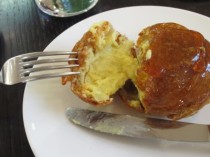 The hot chocolate was super thick and not too sweet. I was way too full for my usual “I just want to try it” gulp, so I took a few sips and waited for the sugar high to knock me to the ground.
The hot chocolate was super thick and not too sweet. I was way too full for my usual “I just want to try it” gulp, so I took a few sips and waited for the sugar high to knock me to the ground.
We realized that there was lots more to try, and no more room in our stomachs. So we bought some caramels to go, with the stern warning from the shopkeeper that they would only be good for a day or two. Not to worry: at 110 euros per kilo, we were only buying a few of them. We savored the last caramel on our last day and realized it was just like our Paris trip: short-lived, sweet, and worth every calorie. So if you only have an hour in Paris, check out Jacques Genin. You may have to run for three hours to work it off, but it’s worth it.
Fake it ’til you make it: an American ajvar experience
 Longtime readers already know about my love for ajvar, so you may not be surprised to learn that one of my most treasured departing gifts was a jar of the ruby goodness from my friend Anja. “My grandmother makes the best ajvar,” she said. “I hope you like it.”
Longtime readers already know about my love for ajvar, so you may not be surprised to learn that one of my most treasured departing gifts was a jar of the ruby goodness from my friend Anja. “My grandmother makes the best ajvar,” she said. “I hope you like it.”
“I love it already,” I said. I eyed the big glass jar and felt my mouth water a little. “I’ll bring it back to America and eat it when I’m homesick for Belgrade.” I imagined gently packing the jar in Politika newspapers and taping it in a Pekara Aca bag to make sure it would be with me on a cold, gray day in America.
Instead, Muz and I ate it two days later. All of it.
Readers, I couldn’t help it. I thought, “I should eat this with Serbian bread. I should enjoy this with Zlatiborski prsut and young cheese. What if the jar broke on the way over? What if–GASP–Muz ate all of it first?” (He does this. Frequently.)
Any Serbian lady over the age of 40 would just look at me and say, “RHOB, make your own ajvar!” But that seems…really hard. And time consuming. And I don’t know where to get roga peppers. So imagine my happy surprise to see this at a Trader Joe’s a few weeks ago: fake ajvar!

Sure, it says “Red Pepper Spread,” but we all know that just means, “ajvar for people who don’t know what ajvar is.” The ingredients were the same. The color….ok, the color was not the same, but I could get past that. When I was ready to try it, I had to force myself to spread it on bread and not eat it straight out of the jar. I popped the bread in my mouth and…immediately frowned.
It’s bad, readers. There’s no other way to phrase it. If you’ve never had ajvar it’s fine, but it lacks the smokiness and velvety texture I was used to. It had a slightly bitter aftertaste that (I think) was due to either using bell peppers or not skinning the peppers properly. Balkan bake (grandmothers) will not be happy about this. And I was increasingly disturbed by the neon orange color. Trader Joe’s “fake ajvar” is, well, fakakta.
Which leads me to a new quest for roga peppers in the D.C. area and a time machine. Or a Serbian grandmother looking to adopt. Any ideas?
You can take the girl out of Chipotle, but you can’t take Chipotle out of the girl: American expats and Mexican food


Two years ago, I briefly joined friends who were taking a year-long trip around the world. We met in Thailand while they were eight months into their adventure. Over Chang beer and fiery noodles, I asked them what they missed about America.
I thought they would say “knowing the language,” “fabric softener,” or “hot showers and air conditioning.” The answer was none of the above. They missed Mexican food.
Now that I have an extra appreciation for how our friends felt, I’m even happier that we tried Mexican food in Thailand. It was a mad experiment in international food relations. Our burrito was more of a spring roll, with thoughtfully applied ketchup in place of salsa. Mexican food in Siem Reap, Cambodia was a little better. The “guacamole” was bright green and appeared to be made of peas, but at least the consistency was right. The chips were made of crispy rice paper and the salsa was edible. I watched my friends savor each bite and thought, these poor souls. They simply don’t remember what it tastes like.
Mexican food is a uniquely American experience. You’d think it would be a uniquely Mexican experience, but no. Unless you live in Texas, the Southwest, or Southern California, “Mexican food” is a bizarre hybrid of American, Latin American, Caribbean and South American cuisine. It’s massive burritos with sour cream AND guacamole, margaritas from a machine, Cuban black beans, and deep-fried taco bowls with salad inside (you know, so it’s healthy). It’s kind of disgusting, and I totally miss it.
 This year, I can relate to my worldly friends more than ever. Belgrade doesn’t really do Mexican food. Serbians are generally not fond of anything spicy. Mexican ingredients are rarer than an empty seat on the 41 bus line. Black beans? Forget it. Hot sauce? Ha! Cilantro is the Bigfoot of Belgrade markets–people claim they’ve seen it, but they can’t remember where. If they do find it, they paid a huge price and then never see it again. Maybe that’s how I should have spent my time here–forming a black market for cilantro and picante sauce.
This year, I can relate to my worldly friends more than ever. Belgrade doesn’t really do Mexican food. Serbians are generally not fond of anything spicy. Mexican ingredients are rarer than an empty seat on the 41 bus line. Black beans? Forget it. Hot sauce? Ha! Cilantro is the Bigfoot of Belgrade markets–people claim they’ve seen it, but they can’t remember where. If they do find it, they paid a huge price and then never see it again. Maybe that’s how I should have spent my time here–forming a black market for cilantro and picante sauce.
There are Mexican restaurants in Belgrade–just not any good ones. Beans are canned and bland. phyllo dough is used instead of tortillas. Some grocery stores do sell flour tortillas (how are Serbians using these?) so at least I can make my own fajitas and tacos. It’s not quite the same.
Fortunately, we found authentic American-Mexican food at Iguana. Unfortunately, Iguana is in…Budapest. Yes, that’s three hours away, but we travel there pretty frequently and three hours is a lot closer than Texas. When the craving gets too bad, Muz and I count down the days until we’re back in Budapest so we can get the best quesadillas this side of the Atlantic. On our last visit, we even ordered jalepeno poppers.
I wouldn’t order these in the States if you paid me, but here they were good. Actual jalepenos, lightly battered, served with a local cheese that was a better replacement for cheddar and sour cream. What’s that on the side? Why, it’s a Michelada: a delicious concoction of lime juice and beer with a salt rim. Technically there should be some tomato juice too, but I’m not complaining.

We’ve been to Iguana five or six times this year, and it never failed to make us happy. It’s a little slice of home in a part of the world where “run for the border” has an entirely different connotation. But now that we’re leaving, I can’t help but wonder if I even remember what it should taste like. I guess I’ll find out soon.
Frugal feasting at Budapest’s Central Market
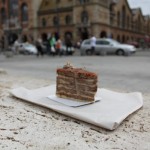
 Budapest isn’t a backpackers’ paradise anymore. EU membership has its privileges—and its prices. Budget accommodations are scarce and restaurants can be pricey. Fortunately, there’s one place that a Real Housewife can find great deals and greater food: the Central Market.
Budapest isn’t a backpackers’ paradise anymore. EU membership has its privileges—and its prices. Budget accommodations are scarce and restaurants can be pricey. Fortunately, there’s one place that a Real Housewife can find great deals and greater food: the Central Market.
I wrote about the Central Market last November, when I focused on souvenirs and smoked meats. There’s nothing wrong with making lunch of salami and a bottle of Tokaj, but the Central Market has more to offer. Upon entering the market, don’t be distracted by people carrying old-school wicker baskets, fruit vendors, and endless paprika stands. Don’t be tempted to buy a pre-made sandwich; STOP RIGHT THERE. That is for amateurs. Go to the second floor and make your way to the left side of the main entrance. You will see a long array of take-away hot food stands. This is where you want to be.
You’ll probably pass a long line of people waiting for langos, a Hungarian specialty of fried bread traditionally topped with cheese and sour cream.

Skip the langos line. Fried bread is okay, but there are far better ways to consume 1,500 calories. It’s not that great, not that cheap (even in the market) and the wait is way too long since every guidebook mentions this place. Pass the glazed eyes of Lonely Planet devotees, walk (or stop) by the wine and beer stand selling 20 ounce white wine spritzers, and end your journey at Fakanal Bistro.
It’s small, humble, and delicious. They’ve got stuffed cabbage, goose legs, fresh breads, goulash—you name it. The service is friendly, and the food is delicious. The location is peaceful but lively. And the prices are low for restaurant-quality food.
If you have room in your stomach after that, make your way downstairs to the bakeries dotting the first floor. There are several, so just choose a place that smells and looks promising. Some specialize in strudel; others have croissants and cookies. My favorite stand has dobos cake to die for.* Dobos cake is named after Hungarian baker József Dobos. It has five layers of cake between chocolate buttercream frosting and is topped with crunchy caramel. The caramel apparently keeps the cake from drying out. It also ensures that the cake will be eaten long before it becomes stale. YUM.
After cake, feel free to get a coffee upstairs or just pass out in the park across from the main entrance. Or better yet, walk off your meal by looking at some of the cheapest souvenir stands in town; they’re located on the other side of the second floor. Your wallet (and your stomach) will thank you. Your skinny jeans….not so much.
To go to the Dobos cake place I mentioned, walk in the main entrance and make your first left. At the end of that row, there will be a bakery on your right and a slightly tired-looking vegetable stand across the way. This is the bakery—apologies for not writing down its name! Get there before 11am for the best selection. The Central market is closed on Sundays.
Behind the Belgrade Bulge: Trpkovic Bakery

Last week I crossed yet another item off the Belgrade Bucket List: follow the advice of commenter Bojan to try raspberry pastry at Trpkovic bakery. Going to Trpkovic felt like destiny. In addition to Bojan, two other people had told me to try Trpkovic last week. They suggested (really, demanded) that I try the burek. Burek is a phyllo pastry “snack” in the Balkans, which means it would be a meal anywhere else. Meat, cheese or spinach is mixed with egg and cream, layered between phyllo dough and brushed with oil. Repeat this process a zillion times, bake it in the oven, and voila! Burek.

Trpkovic bakery isn’t exactly a Belgrade secret. As I approached the door, there were two lines of people waiting. The line out the door was for burek, and the shorter one was for pastries.
 As I waited in the burek line for ten minutes, I was reminded of the “Soup Nazi” Seinfeld episode. There was clearly a method to Trpkovic, and I wasn’t sure what it was. I knew about the two lines in advance, but as I got closer, the process seemed specific and confusing. Usually there’s only one size of burek, but people seemed to be receiving burek of different sizes. Were they asking for it by the gram? I had no idea how many grams were in a small burek. I couldn’t hear orders because the bakery was loud and people were ordering in rapid Serbian. I didn’t want to seem like a Trpkovic twit or worse, be told, “No burek for you!”
As I waited in the burek line for ten minutes, I was reminded of the “Soup Nazi” Seinfeld episode. There was clearly a method to Trpkovic, and I wasn’t sure what it was. I knew about the two lines in advance, but as I got closer, the process seemed specific and confusing. Usually there’s only one size of burek, but people seemed to be receiving burek of different sizes. Were they asking for it by the gram? I had no idea how many grams were in a small burek. I couldn’t hear orders because the bakery was loud and people were ordering in rapid Serbian. I didn’t want to seem like a Trpkovic twit or worse, be told, “No burek for you!”
I told the woman behind the counter that I wanted a small cheese burek to go. This was obviously wrong because she paused. (She had been dishing out burek like a machine.) Then she nodded and disappeared behind a mass of other women taking orders. A second woman asked what I wanted, and I told her I wanted 100 grams of rasperry strudlica (per Bojan’s suggestion). I wasn’t sure if I could order pastry from the burek line, but this seemed okay. She muttered something and handed me a white bag 10 seconds later–just as my burek appeared. It was like magic. Stressful, Serbian magic.
I was running late to meet a friend so I brought the bag with me. I felt triumphant and hungry. I almost forgot to take a photo before I tore into it.
As I suspected, the confusion was totally worth it. The burek wasn’t too crunchy or greasy. The amount of cheese filling was perfect. I made my Serbian pal try a bite for an “expert” second opinion. She said it was the best burek she’s tasted.
After that, we were on a roll—or specifically, rolica. I’d asked for strudlica, but either the waitress didn’t hear me, or rolica was the closest she could get. Either way, these were amazing. They were light, flaky, and burst open with raspberry filling. I took a photo of them in the bag because we were eating them too quickly to guarantee a photo later.
People, the Belgrade Bucket List is going to give me a Belgrade bulge. But it was worth the wait–and the new waistline. Many thanks for all the Belgrade Bucket List suggestions—keep ‘em coming!
Trpkovic Bakery has three locations: Nemanjina 32, Dimitrija Tucovića 60, and Milorada Budžalića 6. I went to the Nemanija location, about 200 meters south of Slavija Circle.
A Year of Days in Belgrade
NOTE: I can’t find my thingee (technical term) that transfers photos to my computer, so I can’t show you all the cool stuff I’ve done this week. Instead, I’m posting a revised essay I wrote in May for my writing group. Hope you enjoy it.
A Year of Days in Belgrade
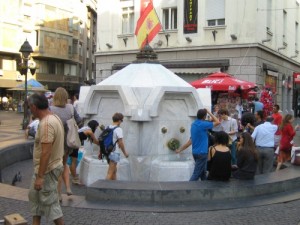 Godinu dana: a year of days. I’m told that’s the proper phrase to use when I explain how long I’ll be in Belgrade. I like this expression; it highlights my urgency to see everything, go everywhere, and eat anything in just 365 days. When I remember this year, I’ll think of the special days that defined the confusion, frustration, and happiness of a life abroad.
Godinu dana: a year of days. I’m told that’s the proper phrase to use when I explain how long I’ll be in Belgrade. I like this expression; it highlights my urgency to see everything, go everywhere, and eat anything in just 365 days. When I remember this year, I’ll think of the special days that defined the confusion, frustration, and happiness of a life abroad.
My first few days in Belgrade were a rainy blur. I was dizzy with jet lag. I had no idea where we lived and was constantly getting lost. To bring some sense into our new life, I started Serbian classes on my third day in Belgrade. After 30 minutes of instruction, the teacher asked if I had any questions. She then blinked rapidly as I asked, “Where can I buy a hair dryer? What do I say when the telephone rings? Why do streets have two different names? After patiently answering all my questions, we ended the lesson in a Bosch appliance store while I asked, “Treba mi fan?”

Then there was the day I ended my semi-vegetarian lifestyle. It didn’t take long. We were invited to lunch at a winery near Topola. The table was heavy with smoked meats and roasted lamb. I tried some dried vegetables instead, only to discover it was duvan čvarci. It was the first day in my life I ate pork rind. It would not be the last.
Life changed quite a bit on the Saturday we picked up our dog. The breeder spoke little English, and our Serbian was rudimentary, but he welcomed us like relatives. We sat shoeless in his living room and admired the juices and sodas carefully displayed on a nearby table. He asked lots of questions and gave us strict instructions. It was my first lesson in the Serbian love for dogs, despite (or because of) the strays I see around town.
One Sunday evening, Serbia suddenly seemed like home. We visited Studenica Monastery and were given a tour of the three churches inside. We drank coffee with a monk and spoke in broken Serbian-English about the church, life in Belgrade, and our families. For the first time in months, I felt as though I was a part of my surroundings, rather than passing through them on a first-class train.
Now I wonder about the days when we return to the United States. I wonder if I’ll overhear Serbian, or if someone will stop me when I’m telling our dog hajde, dosta, and fuje to. If that happens, I’ll say, Zivela sam u Beogradu za godinu dana. A year of unforgettable days.
The RHOB Guide to Survival Serbian
Maybe you already know Serbian. Maybe you ARE Serbian. (Zdravo!) If not, and you’re coming to Belgrade, it’s good to know some words beyond dobar dan (good day) and hvala (thank you). It’s even better to know a few sentences and phrases that will get you through some typical Serbian experiences. These may not be grammatically perfect, but you’ll get your point across.**
Scenario 1: Finding a meal.
 You’re starving. You see white tablecloths, outside seating, and a waiter hovering in the doorway. “Lunch!” you say to yourself. But not so fast…
You’re starving. You see white tablecloths, outside seating, and a waiter hovering in the doorway. “Lunch!” you say to yourself. But not so fast…
You: Da li imate hranu ovde? (Crudely, do you have food here?)*
Waiter: Ne. (No.)
You: Mogu da jedem burek ovde? Super. (Can I eat burek here? Great.)
Note: cafes often look like nice restaurants but serve no food. Ask to bring in food from somewhere else (like a bakery or burek stand) or risk running around from cafe to cafe until your blood sugar drops faster than a Yugo’s value.
Scenario 2: Ending a meal.
 You’re at a kafana, or ever better, someone’s baba is cooking for you. Food has been coming out of the kitchen for three hours. You have to stop this madness before you explode like that dude in Big Trouble, Little China.
You’re at a kafana, or ever better, someone’s baba is cooking for you. Food has been coming out of the kitchen for three hours. You have to stop this madness before you explode like that dude in Big Trouble, Little China.
You: Sve je bila odlicno. Ne mogu vise. (Everything was excellent. I can’t eat another bite.)
Baba: Moras da jedes malo vise. To ce pomoci da beba. (You must eat a little more. This will help you make babies.)
 You: !?!?!
You: !?!?!
Baba: Napravna sam tulumbe, baklava, tufahije i torta. (I made tulumbe, baklava, tufanije and cake.)
You: Necu, ali hvala vama. Ako jedem nesto vise, mozda ja cu umreti. (I can’t, but thank you. If I eat anything else, I might die.)
Baba: Ti ces jesti tufahije. (You will eat tufanije.)
You: Mozda samo malo. Hvala vama. (Maybe just a little. Thank you.)
Note: While in Serbia, prepare to eat until you feel like dying. People will try to feed you until you clutch your heart and run out the door. Argument is useless. Besides, tufahije is awesome.
Scenario 3: Ending an evening at a friend’s house
 You: Ne vise vina za mene. Mislim da je moj jetra je kiseli. (No more wine for me. I think my liver is pickled.)
You: Ne vise vina za mene. Mislim da je moj jetra je kiseli. (No more wine for me. I think my liver is pickled.)
Friend: Stravno? Imam dunya rakija iz cela mog dede. (Really? I have quince rakija from my grandfather’s village.)
You: U redu. Moja jetra nije važno, zar ne? (Ok. My liver isn’t important, right?)
Note: There is little peer pressure to drink alcohol in Serbia. But when you’re offered someone’s homemade rakija, peer pressure isn’t needed. Imbibe carefully.
Scenario 4: Ending an Evening, Part II
[Ring, ring.]
 You: Molim? Sta? Ne, ne mogu da idem u klubu veceras. To je tri ujutru i imam sastanak sutra u osam sati. (Hello? What? No, I can’t go to the club tonight. It’s 3 a.m. and I have a meeting tomorrow at 8 a.m.)
You: Molim? Sta? Ne, ne mogu da idem u klubu veceras. To je tri ujutru i imam sastanak sutra u osam sati. (Hello? What? No, I can’t go to the club tonight. It’s 3 a.m. and I have a meeting tomorrow at 8 a.m.)
Friend: Nole je ovde. (Novak Djokovic is here.)
You: Ja cu biti to za deset minuti. (I’ll be there in ten minutes.)
Note: Just go. You can sleep on the plane. Or when you’re retired.
***
Enjoy Serbia!
*There MUST be a better way to ask this. Srpski speakers, help a housewife out.
**I realize that there are probably several errors here, especially with cases. (Posting late, can’t find my cases cheat sheet, lazy, etc.) Feel free to correct major errors in the comments, but I probably will not correct the main text unless I wrote something offensively incorrect. Have a great weekend, everyone.
Corfu’s kumquat craze

 We thought we knew what to expect from Corfu: lovely beaches, relaxed attitudes, and all the dolmades we could eat. However, there was one unexpected delight in Corfu. Kumquats!
We thought we knew what to expect from Corfu: lovely beaches, relaxed attitudes, and all the dolmades we could eat. However, there was one unexpected delight in Corfu. Kumquats!
I tasted my first kumquat this year and was instantly hooked. Kumquats aren’t often found in Serbia, but a friend somehow found them and offered them to me at the end of a meal. I picked up the grape-sized citrus fruit and popped one, whole, into my mouth. The rind was a bit sour, but the inside was a delicious mixture of sweet and tart. Where had these delicious goodies been all my life? All too soon, kumquat season ended and I was left with visions of buying them at a D.C. Whole Foods for $10 a pound.

This will be $8.99 plus tax next year...
Kumquats are often found in Asia or South Africa, but Corfu received its first trees in the early 1900s. The plant thrived in its new terrain. Today, Corfu is one of the only places in Europe that has achieved “mass kumquat cultivation.” Sounds like an awesome band name. You’re welcome.
Kumquat season was over in Corfu, but the tiny tart treats are preserved as candy and liqueur. We stopped by a shop in Corfu’s old town for a taste test. Though most of the shops here seem to be selling the same things, we were drawn in by this store’s focus on kumquats and their less-cheesy bottles. Plus, isn’t the shopkeeper adorable?
The candied kumquats were fantastic. The sugar heightened the kumquat’s mix of sweet and tart, making it an easy, if not healthy, way to enjoy the fruit year-round. We picked up a box for Muz’s office as I kept sneaking samples. The proprietor then asked us if we wanted to try the kumquat liqueur. Lady, does the Pope wear a big hat? We played it cool, though. Muz waited a solid three seconds before he said yes.
There were several kinds of liqueur available, but we only tasted two. After the shopkeeper learned we liked rakija she dismissed the first two because she thought we would find them “too sweet.” The third bottle from the left was so sweet that I wondered how the other liqueurs didn’t induce diabetic comas. The last one, with the crystals inside, had the mix of bitter/tart/sweet that I like in the kumquat’s original form. And let’s face it, it was also the prettiest bottle.
It was also the most expensive one. As Muz scowled at my “champagne tastes” the woman told us that we could refill the bottle with vodka when it’s empty (When? Five years from now?) and still enjoy something similar. Aha! I insisted it was the more economical choice. A Real Housewife has to think of finances, you know. We purchased a small bottle, secure in the knowledge that my crush on Corfu–and kumquats–could continue in the comfort of our Belgrade home.
Tipsy on Chipsy
I write about food a lot (too much?) but readers might be surprised to discover that I am a fairly healthy eater. Aside from my newfound ice cream addiction, I tend not to eat many processed foods. Of course there’s always an exception. Mine is potato chips. Specifically, tzatziki chipsy.
 I rarely ate chips in America, but guests of ours proclaimed that eating “international” potato chips was something I shouldn’t deprive myself of. While we were on a road trip to Dubrovnik, we tried about five different kinds of chips, with modest success. When we opened the bag of Chipsy tzatziki chips, it was like a porthole into a new universe. A universe of ridged salty goodness. It’s similar to but better than sour cream and onion chips. I think it’s the hint of dill that moves tzatziki chipsy to a whole new level. It’s also difficult to find outside of Serbia and Greece, so there’s an additional “gotta get it” feeling when I see it elsewhere.
I rarely ate chips in America, but guests of ours proclaimed that eating “international” potato chips was something I shouldn’t deprive myself of. While we were on a road trip to Dubrovnik, we tried about five different kinds of chips, with modest success. When we opened the bag of Chipsy tzatziki chips, it was like a porthole into a new universe. A universe of ridged salty goodness. It’s similar to but better than sour cream and onion chips. I think it’s the hint of dill that moves tzatziki chipsy to a whole new level. It’s also difficult to find outside of Serbia and Greece, so there’s an additional “gotta get it” feeling when I see it elsewhere.
Chipsy is the main potato chip game in the Balkans. There must be at least 10 different flavors. I can say with authority that tzatziki is the best flavor, and mladi sir (young cheese) is the most disappointing. The worst, by far, is hot dog.
Let’s not even examine why “hot dog” should be a chip flavor. Let’s just say it does actually taste like a hot dog, and that means it’s gross. Of course Muz loved them. Muz also ate hot dogs every day for three years straight. And readers, I married him.
So a word to the wise traveler: try potato chips in new countries! If you’re like me, you’ll like (most of) the new flavors and find yourself singing, “Errybody in the club getting Chipsy” until your husband threatens to pull the car over. Enjoy!
Paradajz found

The Serbian word for tomato is one of the easiest to remember: paradajz. It’s roughly pronounced like paradise, which is exactly what it tastes like right now. Serbia is one of the world’s biggest raspberry exporters (random fact!) but it really should look into exporting tomatoes, because these babies are incredible.
It seems like a good tomato year, because stores are practically giving them away. This photo was taken in July, but recently I saw tomatoes being sold for 15 dinars a kilo–people, that’s 10 CENTS a pound. Don’t get too excited, though. Usually the markets sell them for a whopping 25 RSD/kilo, or 17 cents per pound. Going to the market right now is like landing on Mars and seeing free diamonds lying around. Edible diamonds.
Of course, tomato season won’t last forever, so I’m trying to enjoy them whenever possible. I have elaborate plans of making a vanilla-infused tomato and citrus tart one day, but I get lazy/don’t have the right ingredients/am suddenly hungry and wind up enjoying them in their perfect form: the shopska salata.
If you’re in Serbia between May-October and don’t get a shopska salata, you should be arrested. Or pitied. It’s the world’s best salad, with nothing but tomatoes, cucumbers, onions and hot peppers, topped with a Serbian cheese that tastes similar to grated feta. The cheese is much better than what’s normally available in the States, though I imagine there are some cheesemongers–I love that word–who make a high quality feta that will do. And if you’re in Serbia, one shopska is large enough to be dinner, unless you’re with Muz, who believes that there is no such thing as a meatless dinner.* Yet even meat-loving Muz agrees that tomatoes in Serbia are simply paradise, I mean, paradajz.
True story: He once said to me, “This dinner is good, but don’t think I didn’t realize it is vegetarian,” as if lentils were horse meat or something. He was totally ON to my healthy eating TRICKS, you see, and he wasn’t going to let it just slide by. Genius. Though to be honest, I was hoping he wouldn’t notice.
Njegos Prsut: When a ham by any name is NOT the same
In the Balkans, people take their poetry and prosciutto seriously. So when we learned that there was a Montenegro prsut (prosciutto) named after a poet, we knew it had to be good.
We were right.
Njegoš prsut is named after Petar II Petrović-Njegoš. (Try to say that three times, fast.) Njegoš wrote famous epic poems, including The Mountain Wreath. For non-Balkanites, he’s what Shakespeare is to England. The Mountain Wreath is Balkan’s Hamlet. If I polled 10 Serbians on the street, I’d bet at least 7 of them could recite lines from his poems.
He wasn’t merely a poet, however. He was born into local royalty during the Ottoman hold over Montenegro. Eventually, he was made Bishop and helped form the various clans in Montenegro into a unified state. He’s seen as a benevolent king and has more likes on his Facebook page than I do. (Though so do most people…)
Best of all, he’s the namesake behind the smoked, dried ham pictured above. It’s sliced thin-to-medium thickness and doesn’t taste overly salty. The smoke flavor is there, but barely. It didn’t melt in our mouth but it did offer a delicate texture and hearty flavor. The secret is supposedly the grazing lands in Montenegro, though I’d imagine that many butchers have a special technique or two during the aging process. Whatever the secret is, it’s safe with Montenegrins, who assured (taunted?) us that we couldn’t get this kind of prsut anywhere else. Oh well. Njegos’ words may roll off the toungue, but his prsut rolls right on in.
UPDATE: a kind reader told me the following: It’s not named after (Petar II Petrović) Njegoš, it’s named after a village Njeguši (after which is Njegoš dynasty named too), nearby Cetinje, Montenegro. Njeguški pršut, not Njegošev pršut.
Darn it.I thought our waiter told us that it was named after the King, not the King’s hometown. I’m keeping the post though since I have more to say about Njegos tomorrow. As always, thanks for clarifying!
The Fairy Tales, Tastes and Truffles of Motovun, Croatia
 Motovun is the stuff of fairy tales. It appears almost out of nowhere: a turn on a highway suddenly reveals the white hilltop city lording over olive groves, vineyards, and truffle patches. It’s Disneyland for wine-swilling, food-loving adults. Obivously I had to go there.
Motovun is the stuff of fairy tales. It appears almost out of nowhere: a turn on a highway suddenly reveals the white hilltop city lording over olive groves, vineyards, and truffle patches. It’s Disneyland for wine-swilling, food-loving adults. Obivously I had to go there.
I drove there with my latest partners in crime: Zločin, aka “Felony”–she knows why–and Lingvista, or Linguist, because she used the same five Serbian/Croatian words in every conversation. If you want strangers to like you, bring along a friend to likes to tell everyone “Volim te.” They were the perfect duo for my latest adventure.
Our final destination was Rovinj, but we stopped in Motovun at the advice of a Croatian friend, bolstered by an Italian man’s claim that Istria, the region of both Rovinj and Motovan, was “better than Tuscany.” As we walked around the old city, we understood the hype. It was a small town filled with gorgeous views, wine stores, truffle specialists and lovely restaurants. Though my guidebook claimed that it was often overrun with tourists in high season, we had the area practically to ourselves.
 Motovun isn’t just the stuff of RHOB fairy tales. It’s also the setting of a famous Croatian fairy tale about a giant named Veli Jože. Based on my sketchy language skills, he was a giant who lived in Motovun and tried to (1) be a free man, (2) stop other giants from being greedy with their newfound gold stash, and (3) possibly help the people of Motovun, who didn’t want to feed the giants but were his friend. Obviously my translating skills need serious work. Here’s an English summary that may not be any better…
Motovun isn’t just the stuff of RHOB fairy tales. It’s also the setting of a famous Croatian fairy tale about a giant named Veli Jože. Based on my sketchy language skills, he was a giant who lived in Motovun and tried to (1) be a free man, (2) stop other giants from being greedy with their newfound gold stash, and (3) possibly help the people of Motovun, who didn’t want to feed the giants but were his friend. Obviously my translating skills need serious work. Here’s an English summary that may not be any better…
Unfortunately we weren’t able to eat at some of the finer dining establishments because we arrived after two and before six pm. Still, we were able to get good pizza and great truffle pasta at a place with a view of the valley below us. The local wine was delicious but a bit of a mystery. Upon our inquiry we were only told that it was “white.” I figured it was malvazija wine, since the other local specialty wines are white muscatel (a distinctive taste) and teran, a red wine.
 We tried to pick up a similar bottle in the local stores but were disappointed with the high prices and minimal selection. Fortunately we found a small shop on the outskirts of town that offered local prices and atmosphere. After Lingvista picked up enough fruit for a small army, we grabbed an edible souvenir for our evening in Rovinj. Cinderella may have received a glass slipper, but RHOB lucked out with a glass of Istrian white. That’s my kind of fairy tale.
We tried to pick up a similar bottle in the local stores but were disappointed with the high prices and minimal selection. Fortunately we found a small shop on the outskirts of town that offered local prices and atmosphere. After Lingvista picked up enough fruit for a small army, we grabbed an edible souvenir for our evening in Rovinj. Cinderella may have received a glass slipper, but RHOB lucked out with a glass of Istrian white. That’s my kind of fairy tale.
So, what’s Prague LIKE?

 I know, readers, I know: I get so wrapped up in showing snippets from our travels that I neglect to offer general impressions. Here’s one Housewife’s take on Prague.
I know, readers, I know: I get so wrapped up in showing snippets from our travels that I neglect to offer general impressions. Here’s one Housewife’s take on Prague.
In one (overused) word, Prague is charming. Unlike many of its neighbors, Prague was spared severe bombing in World War II so the city’s gothic, neoclassical, baroque and art nouveau buildings are well-preserved. If you don’t know what those terms mean, not to worry: it’s really pretty. Yet there’s enough realism to make the city approachable. Many buildings are cloaked in soot. At night, the statues on Charles Bridge are covered in spiders. It’s interesting without being imposing.
Guidebooks give the Old Town the most acclaim, but I found Lesser Town to be the best place for a stroll. I liked the cafes, hidden streets, and quirky sense of irony and artistry. It’s also the old German area, for those looking for a bit of history with their espresso.
If you’re not into architecture, the city’s park system is a lovely way to pass an afternoon. We saw lots of picnics with wine bottles. Based on the number of sporting goods stores we saw, there are also hiking opportunities outside of the city. The Czechs seem to be fit, but not overly friendly. We didn’t chat with many locals. Then again, I imagine the appeal of meeting foreigners lost its luster long ago. Most people speak English well, though our Serbian came in handy at the rail station. Basic Serbian vocabulary is surprisingly similar to Czech.
Though Prague is no longer the cheap destination it was in the late 1990s, there are still tons of backpackers. We heard a lot of Spanish, Italian, and English. I’m past my backpacking phase of life (sort of), but it was fun to see so many people ready to take on the world with a tent and a rucksack.
The only part of Prague that disappointed us was the food. We didn’t go to high-end restaurants, but the local, traditional cuisine is a little bland. Meat is not as tasty as it is in Serbia. Restaurant service is indifferent. Yet beer is cheap and delicious. We didn’t see any stag parties but I hear they are ubiquitous on the weekends.
Would I recommend Prague? Absolutely. It’s gorgeous, easy to get around, and has a unique culture. Yet Prague is “on the map,” so to speak, and will continue to be a popular destination for people past the hostel stage. If you’re looking for adventure, I’d recommend other Eastern locales. Still, you can’t beat the romance of Prague…and the humor behind the public art.
RHOB Reviews: Bacio Ice Cream Shop
 I planned to eat super healthy this summer to make up for all the sarma and cevap I ate in winter. The plan was working pretty well…until I found Bacio.
I planned to eat super healthy this summer to make up for all the sarma and cevap I ate in winter. The plan was working pretty well…until I found Bacio.
An Italian friend introduced me to the place. “It’s not Italian gelato, but it’s pretty good,” she said. If you don’t know an Italian person this is a HUGE compliment. I’ve never heard someone from Italy proclaim that any other country made food nearly as well as Italians. Sadly, they’re usually right. Yet Bacio gives pisani a run for their money.
The gelato is quite good. Flavors are all natural but smooth. The coconut is my favorite–it’s delicious without getting tiny shards of coconut in my teeth. Best of all, they make special popsicles and ice cream sandwiches.
They also offer a huge, crazy pineapple boat with six flavors inside, but I was too chicken to try it. If you’ve got a big group or a big appetite, hustle down to Njegoševa 1a (right by Vesele Domacice) and try out a taste or two. Before I eat everything.
The Legend of Loki
Belgrade has many legends, but there’s only one that managed to rally hundreds of people around the humble pljeskavica. Meet Belgrade Legend Sasa Mitrovic, the owner of the food stand Loki.

Image source: http://tinyurl.com/3ccdq2y
It all started over twenty years ago, when Mitrovic opened Loki in a public square near Kralja Petra. His food stand sustained Serbians with pljeskavica, cevap, and gurmanska 24 hours a day, 7 days a week. A loyal following developed among hard-partying Beogrdjani emerging from bars at four in the morning. Loki became a quintessential Belgrade experience, like walking on Knez Mihailova or getting ripped off in a taxi from the airport.
But in 2010, the good times were coming to an end for the humble, green-roofed shack. Kralja Petra’s fortunes were rising–and so was the value of the land that Loki sat on. Based on rumor and my poor translation of news articles, it seems that Mitrovic didn’t own the land, but tried to claim that Loki had historic value that prevented a tear-down. Celebrities, models and sports starts called for Loki to remain on municipal land. Authorities were undeterred. A court ruled that Loki would be no more.
Beogradjani took to the streets to prevent Loki from being torn down. At least five police showdowns occurred. Workers, patrons, and Mitrovic himself formed human barriers to prevent the bulldozer from breaking down tradition. During the fifth stalemate, Mitrovic locked himself in his kiosk and threatened to light it on fire if the police dared to come any closer. He was subsequently arrested, along with 50 other people. Loki was later bulldozed to the ground.
The legend doesn’t end there. Several weeks later, Mitrovic opened a new Loki not far from his old location. The new Loki was in a proper storefront that some claim Mitrovic owned for many years. It still stands there today.
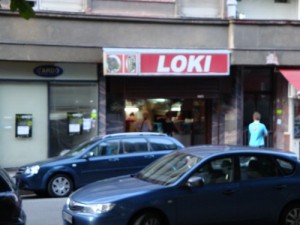 The bulldozed area, as I best understand it, is now the home of a…Telecom Srbija hut. Sigh.
The bulldozed area, as I best understand it, is now the home of a…Telecom Srbija hut. Sigh.
My question is, why didn’t Mitrovic use his storefront before things came to fisticuffs? Perhaps he wanted to thumb his nose at Belgrade authorities/prospecting real estate investors. Maybe he wanted to keep the storefront as a private bar for close friends. Possibly, he bought it in the months leading up to the court decision, knowing the Loki stand would one day be no more. Or maybe…he knew that a legend always needs a little mystery.
*For a proper rendition of facts, see the Serbian article about the arrest here. Information about the old Loki is scarce, so feel free to correct me/add your own impressions in the comments.
Slices of Serbia: a pizza pity party
When I was researching Belgrade in preparation for our move here, guidebooks and blogs all seemed to agree on one thing: no one comes to Serbia for the pizza. I thought this was fine. I mean, we weren’t coming to Serbia for Mexican food, either. Who cares if the pizza is bad? As I read more on the subject I discovered why Serbian pizza horrifies the casual traveler. It’s not because the crust is too thick or thin. It’s not because the ingredients aren’t fresh. It’s because if you’re not careful, your pizza slice could be covered in ketchup. Specifically, pizza ketchup.
Oh yes, this is real. Pizza menus will describe their pizzas as having cheese, tomato, pepperoni…and ketchup. But RHOB, this isn’t really ketchup, right? It’s something else. Nope, this is ketchup. Actually, it’s a little sweeter than American ketchup, so in some ways it’s worse than Heinz 57 or something similar.
But not to despair, non-Serbian pizza lovers! Many places offer pizza without the ketchup. And there are several Italian restaurants in Belgrade that serve Naples-style pizza sans red stuff. There’s even a Pizza Hut on Makedonska. I’ve never been there though so I can’t comment on their ketchup policy.
Truthfully, it’s not the ketchup that tourists should be concerned about: it’s the marinara sauce. This is the most confusing part of ordering pizza here. Sometimes, the marinara sauce is good. Really good. I’ve drizzled it on white pizza or dipped my pizza crust in it. Other times, it’s awful: a processed, sweet goop with chunks of canned tomato in it. STAY AWAY. When you get the side dish of sauce, it’s hard to tell whether you’ve got the good stuff or not–so you’ve got to ask yourself…do you feel lucky? Well, do you?
Overall, I think Serbian pizza isn’t great, but I have a few places that satisfy the craving in Belgrade. The best pizza I’ve had here was in Novi Sad at Kuca Mala, pictured above. Excellent cheese-to-toppings ratio, a nice crust (not too doughy) and decent marinara sauce. Muz’s pizza was just ok. He made the odd choice of getting the Mexican pizza, which featured corn and…carrots. People may not come to Serbia for the Mexican food or the pizza, but they certainly won’t stay for a Mexican pizza.
RHOB Reviews: Mojito Ice Cream
Do you like mojitos? Do you wish you could have mojitos all day long, but not in a way that interferes with your job/child/need to operate heavy machinery? I totally understand. Let me ask you one more question: do you also like ice cream? Yes? Then move to Belgrade, and enjoy Top Gun Mojito ice cream. For reals.
Sometime in the spring, I started seeing ads featuring a weird guy in a green suit, half-naked women, and a fake beach. I thought it was a beer commercial for the first 10 seconds, but it turned out to be a mojito ice cream cone commercial.
There are about 10 versions of this ad. I picked the least annoying one. You’re welcome.
 Top gun seems like an odd name for ice cream. Mojito seems like an odd flavor. I was intrigued. So during yesterday’s sweltering heat, I bought a cone for “research.” Upon peeling the foil off, I noticed that there was an excellent ice cream-to-cone ratio.
Top gun seems like an odd name for ice cream. Mojito seems like an odd flavor. I was intrigued. So during yesterday’s sweltering heat, I bought a cone for “research.” Upon peeling the foil off, I noticed that there was an excellent ice cream-to-cone ratio.
The flavor is pretty good. It’s basically a mild mint ice cream with a vague aftertaste of alcohol. Ever notice that most non-alcoholic alcohol flavoring isn’t very good? I did. But as I continued to eat the cone the aftertaste went away, or I got used to it. I ate the malt-ball candy at the top of the come and thought, hey, this is pretty good.
As I worked my way to the cone, I found a delightful lime-like jam in the center. At least, I hope it was jam.
Finally, I ate the surprisingly crispy cone with chocolate coating on the inside. Genius.
I know Europeans love their ice cream, and I am starting to understand why. This was no ordinary rocket pop, chipwich, or even a King Cone. This was an overly complicated treat based on a cocktail. What’s not to love?
Of course, there’s no alcohol content to the cone. Troubling for tipplers, but good news for parents who don’t want their children getting drunk at the local corner store. (But mama, it was just ice cream!) Besides, I can tell you from personal experience that adding alcohol to ice cream-specifically, Slushees-makes them melt faster. But that’s a story for another time.
Consider me sold, Nestle. I’m looking forward to picking up a few more mojito cones this summer, but I hope I don’t run into the guy in the green suit. He gives me the creeps.
Belgrade Bounty
Hello, my name is RHOB, and I am a fruit-aholic.
This is my loot from my last pijaca (farmer’s market) trip: zucchini, eggs, cherries, currants, raspberries, nectarines, and whatever these tiny pear-things are. Even better, I bought all of this for about what the flowers alone would cost in the U.S.
Serbia is an amazing place for fruit lovers. Cherry and apricot trees grow all over the place-even in a nearby parking lot-and markets are bursting with colorful fruits and veggies. The grocery stores can’t catch up with the farmers, so I’ve been making regular trips to the pijaca and buying fruits I can’t identify. For instance, I’ve discovered the amazingly tart taste of fresh currants, but it took the wonders of Twitter (and @Cneable and @Erasfa) to figure out what I was eating. Though we travel around the region quite a bit, wandering around the pijaca is a great adventure in itself.
RHOB and the Bright Lights of… Brașov
While we were staying in Sinaia, we drove to Brașov for the afternoon. Brasov is a larger tourist town in Transylvania and a popular base for people touring the region. The city is also noted for several things:
1. its tourist-eating bear population (no hikes for us, thanks)
2. a quaint medieval district (see left)
3. beautiful countryside (the setting for the movie Cold Mountain)
4. And this sign:
Here’s the close-up:
The culinary delights of Karaköy, Istanbul
Karaköy sits across the river from Istanbul’s most famous sites. It’s south of the Galata tower and dotted with markets selling everything from fish to toilet seats. While it’s not the most popular place for tourists, it might be one of the best places to enjoy a cheap and tasty meal in Istanbul. Thanks to our trusty tour guide, we checked out the following treats.
Muz believes that dessert should be the first course of any meal, so we first stopped by the famous Güllüoglu for some baklava. If you believe the hype, the founding owner of this establishment introduced the dessert to Turkey in 1871. Dentists and diets have flourished since. Muz didn’t want to miss out on any combination of phyllo and honey, and wound up getting a little taste of each kind.
I thought we were being excessive, until I looked at the table next to us. Two Turkish men were sharing a plate larger than ours. Kuma, Muz and I dug in, not stopping for air or conversation. It was all delicious, except for the chocolate. (WHY would you ruin this delicacy with chocolate?!) What wasn’t delicious was the raging headache that followed my sugar high. We needed protein, quick, so we walked to the fish market for a sandwich.
Across the river in Old Town, floating boats are famous for their giant fish sandwiches. Online message boards show heated conversations about the best fish boat. But most of the fish sold there, we were told, isn’t local. So we went straight to the source: the fish market on the opposite side of the river.
It was definitely not the tourist scene. Slush water from the fish cooling system spilled on to the path. Vendors scowled at us, knowing we were only there to look. Fish scales were everywhere. Between the little fish graveyards, we saw an entryway and a few tables packed with people. We ignored the extensive menu and asked for three fish sandwiches and drinks.
Once again, the portions were massive. But in the name of bloggerism, dear readers, I managed to finish off my yummy sandwich. It wasn’t a gourmet meal, but it was definitely a cheap one. The bill for all three of us was about $13 USD.
There was more to explore on this slightly sketchy side of the Bosphorous, like fresh squeezed juice pressers and fruit and roasted nut vendors, but alas, we were full. On our way back to our hotel, we discovered the additional benefit of eating in Karaköy: enjoying a much-needed walk home on the Galata Bridge during sunset. It may not have been the fanciest meal in Istanbul, but it was one of the most memorable.

